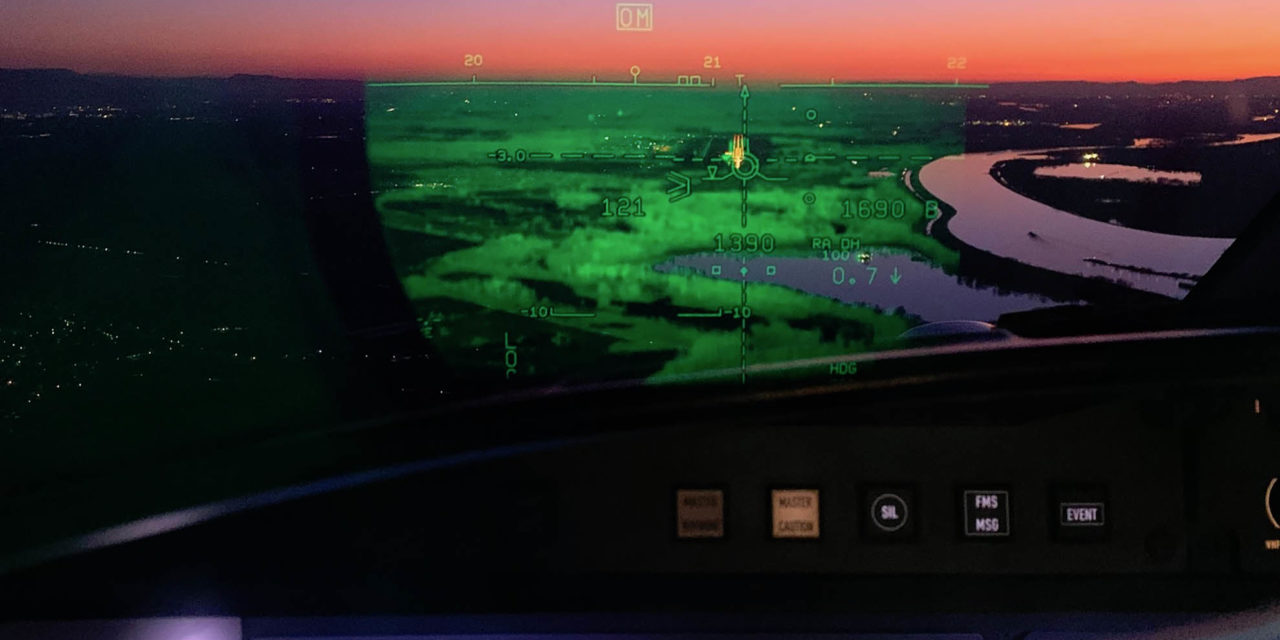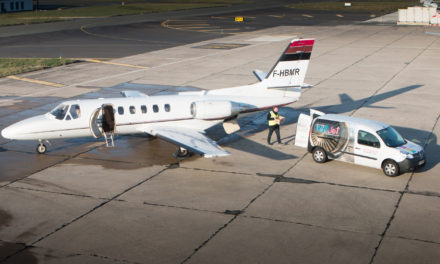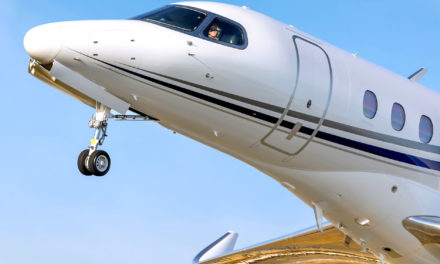By David Zara
I normally tend to avoid writing overly technical articles about all things concerning aviation but I may have to make somewhat of an exception today. I was confronted by an avalanche of acronyms and ladled in a soup of alphabet-defying groups of three capital letters demanding to be understood.
FalconEye, the subject at hand lends itself to technical explanations but I’ll first wax poetic as much as possible and start by saying it’s an amazing system. I was given a thorough briefing by the Dassault team and their pilot-tech guru Arnaud Paulmier. Flying with FalconEye made me feel as if I stepped into a time-machine and hit fast-forward.
Intuitive
I tested the system on a Falcon 8X with Franco Nese and Nicolas Linehan on a blustery winter day with winds gusting up to 30 knots. While most crews would have wisely opted to remain on firm ground, most pilots are not mounted on steady steeds like a Falcon 8X nor perhaps do they have the skill-set of Dassault’s finest. The weather was challenging enough that most flight departments would have cancelled the demo but Franco and Nicolas soldiered on with on a big smile instead and nary a complaint.
We launched at sunset to best sample the full capabilities of FalconEye and we were not disappointed. Even though I have flown with most Heads Up Displays (HUD) systems available in the marketplace, I don’t consider myself particularly conversant with HUD’s in general but FalconEye is so intuitive I quickly forgot I was looking through a glass pane. The information available is so complete it defies the imagination. Night and darkness surrender their mysteries to FalconEye while clouds reveal their location when the Enhanced Vision System (EVS) is called to action.
WII or « Works In Ice »
FalconEye is a combination system and it begins with the HUD coupled with the Enhanced Vision System (EVS). It is comprised of three major sub systems. An overhead Combiner Unit (OCU) based on LCD technology along with an Overhead Projector Unit (OPU) work together to create an electro-optical system that displays flight-critical information in symbolic form and creates an image for the pilot to see. Display symbology and the image are generated by the Computer Unit (CU). The EVS system is composed of 6 sensor cameras. There is a night sensor to detect lights in dark situations and four day-time sensors aided by a thermal sensor for terrain imaging. The EVS high resolution video feed is created by the fusion of all 6 sensors and is generated by the camera itself. This system works in ice conditions as well. Strangely, there was no acronym for this unit so I made one up-I named it WII and decreed it stands for “Works In Ice”. All joking aside, the EVS works remarkably well in snowy conditions.
One thing that makes this system so useful is its wide field of vision. With 40 degrees of horizontal and 30 degrees of vertical field of vision I felt none of the narrow tunnel vision I expected. The same coverage is available for the SVS system. This system is multilayered with terrain, airports depicted by their ICAO nomenclature and runways shown at the destination. Obstacles greater than 200 feet above ground level such as buildings and antennas are displayed if they are 10 nautical miles from the aircraft.
The EVS produces a real image to improve the pilot’s visibility in challenging conditions but FalconEye’s capabilities go well beyond that. What makes FalconEye different and so superior it the system’s ability to layer all the information it generates. One brilliant feature is the automatic reversion to a clear path when in proximity and aligned with the landing runway. It essentially declutters the image eliminating the “synthetic” information to preclude any erroneous information which could induce the pilot to make a mistake. I used the word pilot in the singular but one more safety-enhancing feature of this system is that unlike the competition’s products FalconEye will soon be approved for installation in front of both pilot seats. The whole point of Crew Resource Management or CRM is for crews to work together but that’s not really possible when only one crew member has access to critical information. One more important feature is right-seaters will be more than familiar with the system by they the time they transition to the left seat. I decided to create one more acronym for this and named it RLI which stands for Right-seaters Love It. When in the clear zone the system will continue to display obstacles and SVS symbology. One more interesting feature and certainly one that will become more relevant as more airports convert to LED lighting is its ability “see” LED lights. Conventional HUD systems can’t.
Combined Vision System
I also greatly appreciated the ability to choose how much of each system I wanted up on the HUD display. I could dial more SVS above the horizon or less if I wanted to. When flying in a mountainous area this could be a life-saving feature. The mountains may be pictured synthetically but they are still made of real hard rock and granite and knowing where they are is quite comforting. There is a CVS balance annunciation via a bar graph on the bottom left of the HUD to display the ratio between the EVS and SVS information.
FalconEye is different in one very salient way and the magic acronym is CVS which stands Combined Vision System. In simple terms, it’s a combination EVS and SVS and it allows pilots-note again the use of the plural-to take advantage of both types of images. While EVS is sensor based and can “see” clouds, vehicles, roads and bridges and buildings it is limited by weather conditions. SVS is an electronic computer-generated tridimensional data-based display of what is theoretically in front of you. It’s restricted to basic terrain features but it’s not dependent on weather conditions. CVS combines the best of both these systems. One more thing about FalconEye is its ability to allow pilots to operate in all phases of flight. From taxiing out to taxiing back into the ramp after a flight, pilots can use and rely on the system throughout the whole flight and frankly there’s no reason not to. The system was designed to perform in all phases of flight and to that end the engineers and test pilots at Dassault decided more than 15 years ago that pilots didn’t need to be “bombarded “ by information which was not relevant to the phase of flight they were conducting. Pilots don’t need to know about altitude or speed when taxiing so FalconEye will automatically declutter the display on the ground. The same concept applies to other phases of flight and the transition is seamless. When landing there’s a touchdown zone depicted on the HUD and as long as you keep the “small fish” inside the “big fish” you’ll get there regardless of headwind or crosswinds or anything else nature throws at you. It’s that simple-you aim, you follow through and you’ll get there. One question no one has been able to answer is how the system is able to compensate for my nearsightedness. I could see both close-up and far away as long as I used the HUD. There was no acronym for that so I again made one up-ILI which stands for I Love It.
Simpler, Safer
What makes FalconEye such a joy to fly with is that a system as complex as this has been made so easy to operate via a simple set of controls on the yokes or sticks.
FalconEye was so much fun to use that I almost forgot to look outside. It was a pitch black night and the one time I remembered to look out I saw nothing but black ink outside. FalconEye gave me a glimpse of the future and in the 8X I saw no need to ever turn on the autopilot-not even in turbulence. Marketplaces tend to catch up to innovators but technological unicorns such as FalconEye will be harder to copy. In the interim, insurance companies would be wise to lower their premiums for owners that invest in safety and crews that strive to make aviation even safer. It would be a pity for insurers not to reward manufacturers who design and users who adopt better practices. Funny thing about FalconEye is that I had an epiphany on my way back home after the flight. Unlike most aircraft systems and to the immense credit of the team that developed it, flying with FalconEye is much easier than describing it.









